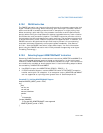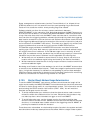
Vol. 3 8-67
MULTIPLE-PROCESSOR MANAGEMENT
Power management related events (such as Thermal Monitor 2 or chipset driven
STPCLK# assertion) will not cause the monitor event pending flag to be cleared.
Faults will not cause the monitor event pending flag to be cleared.
Software should not allow for voluntary context switches in between
MONITOR/MWAIT in the instruction flow. Note that execution of MWAIT does not re-
arm the monitor hardware. This means that MONITOR/MWAIT need to be executed in
a loop. Also note that exits from the MWAIT state could be due to a condition other
than a write to the triggering address; software should explicitly check the triggering
data location to determine if the write occurred. Software should also check the value
of the triggering address following the execution of the monitor instruction (and prior
to the execution of the MWAIT instruction). This check is to identify any writes to the
triggering address that occurred during the course of MONITOR execution.
The address range provided to the MONITOR instruction must be of write-back
caching type. Only write-back memory type stores to the monitored address range
will trigger the monitor hardware. If the address range is not in memory of write-
back type, the address monitor hardware may not be set up properly or the monitor
hardware may not be armed. Software is also responsible for ensuring that
• Writes that are not intended to cause the exit of a busy loop do not write to a
location within the address region being monitored by the monitor hardware,
• Writes intended to cause the exit of a busy loop are written to locations within the
monitored address region.
Not doing so will lead to more false wakeups (an exit from the MWAIT state not due
to a write to the intended data location). These have negative performance implica
-
tions. It might be necessary for software to use padding to prevent false wakeups.
CPUID provides a mechanism for determining the size data locations for monitoring
as well as a mechanism for determining the size of a the pad.
8.10.5 Monitor/Mwait Address Range Determination
To use the MONITOR/MWAIT instructions, software should know the length of the
region monitored by the MONITOR/MWAIT instructions and the size of the coherence
line size for cache-snoop traffic in a multiprocessor system. This information can be
queried using the CPUID monitor leaf function (EAX = 05H). You will need the
smallest and largest monitor line size:
• To avoid missed wake-ups: make sure that the data structure used to monitor
writes fits within the smallest monitor line-size. Otherwise, the processor may
not wake up after a write intended to trigger an exit from MWAIT.
• To avoid false wake-ups; use the largest monitor line size to pad the data
structure used to monitor writes. Software must make sure that beyond the data
structure, no unrelated data variable exists in the triggering area for MWAIT. A
pad may be needed to avoid this situation.
These above two values bear no relationship to cache line size in the system and soft-
ware should not make any assumptions to that effect. Within a single-cluster system,


















